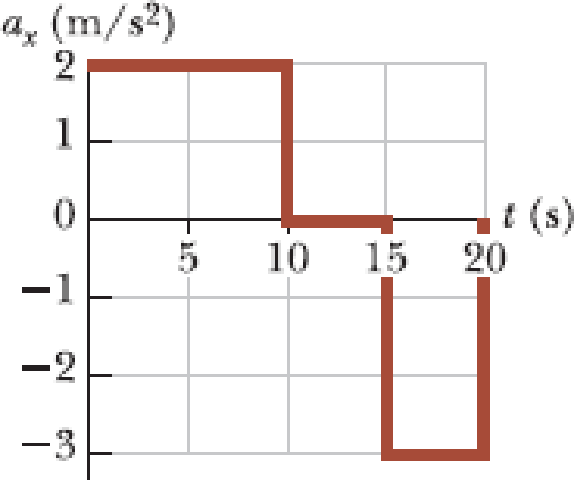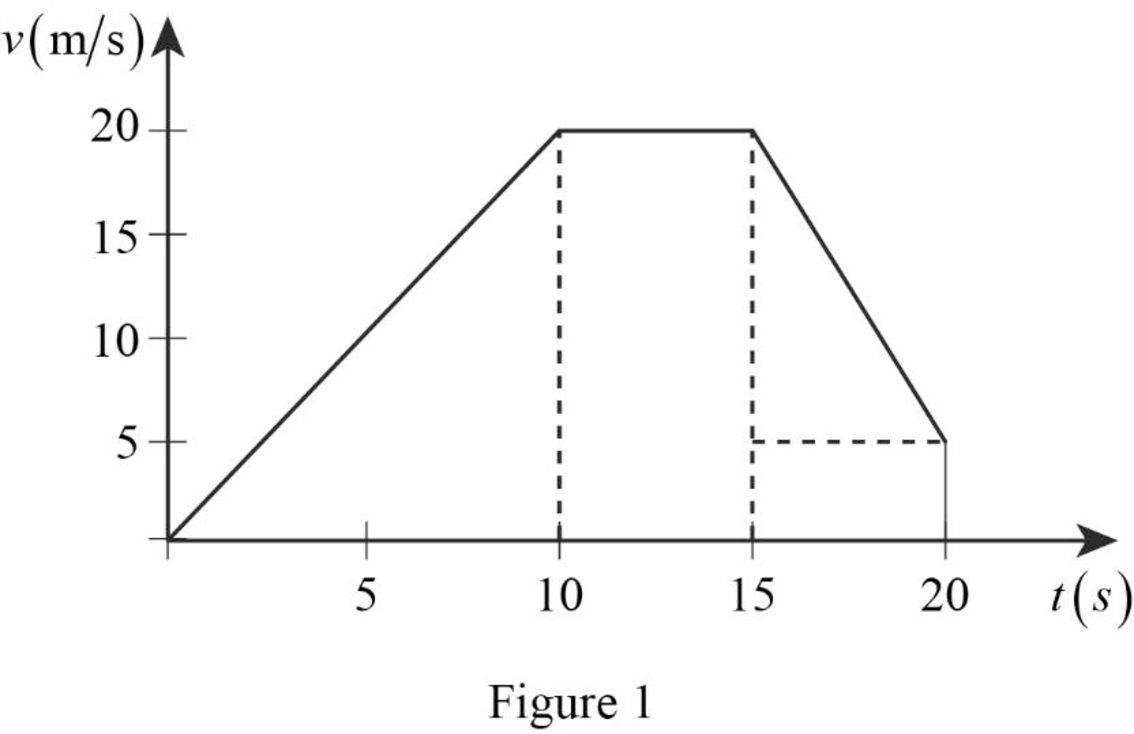
Concept explainers
A particle starts from rest and accelerates as shown in Figure P2.13. Determine (a) the particle’s speed at t = 10.0 s and at t = 20.0 s, and (b) the distance traveled in the first 20.0 s.

(a)
The particle’s speed at
Answer to Problem 13P
The particle’s speed at
Explanation of Solution
Write the equation for the final velocity of a particle.
Here,
The area under acceleration versus time graph under specific time intervals gives the change in velocity of the particle during the time interval. Speed is the magnitude of velocity.
The sides of a unit rectangle in the graph are
The area under the graph in the interval
Since the particle starts from rest, its velocity at
Substitute
The area under the graph in the interval
Substitute
Conclusion:
Therefore, the particle’s speed at
(b)
The distance travelled in the first
Answer to Problem 13P
The distance travelled in the first
Explanation of Solution
The area under velocity versus time graph under specific time intervals gives the displacements during the time interval.
In part (a), it is found that the velocity at
The velocity versus time graph is shown below.

The area from
Write the equation for the area of a triangle.
Here,
In figure 1, the base of the triangle from
Substitute
Here,
The area from
Write the equation for the area of a rectangle.
Here,
In figure 1, the length of the rectangle from
Substitute
Here,
The area from
In figure 1, the base of the triangle from
Substitute
Here,
In figure 1, the length of the rectangle from
Substitute
Here,
Write the equation for total distance travelled.
Here,
Conclusion:
Substitute
Therefore, the distance travelled in the first
Want to see more full solutions like this?
Chapter 2 Solutions
Principles of Physics: A Calculus-Based Text
- Lab 8 Part 3 PHET Wave Interface simulation. I am having trouble with this part of the lab.arrow_forwardMick and Rick are twins born on Earth in the year 2175. Rick grows up to be an Earth-bound robotics technician while Mick becomes an intergalactic astronaut. Mick leaves the Earth on his first space mission in the year 2200 and travels, according to his clock, for 10 years at a speed of 0.75c. Unfortunately, at this point in his journey, the structure of his ship undergoes mechanical breakdown and the ship explodes. How old is Rick when his brother dies?arrow_forwardHi, I have canceled, why did you charge me again?arrow_forward
 Principles of Physics: A Calculus-Based TextPhysicsISBN:9781133104261Author:Raymond A. Serway, John W. JewettPublisher:Cengage Learning
Principles of Physics: A Calculus-Based TextPhysicsISBN:9781133104261Author:Raymond A. Serway, John W. JewettPublisher:Cengage Learning Physics for Scientists and Engineers with Modern ...PhysicsISBN:9781337553292Author:Raymond A. Serway, John W. JewettPublisher:Cengage Learning
Physics for Scientists and Engineers with Modern ...PhysicsISBN:9781337553292Author:Raymond A. Serway, John W. JewettPublisher:Cengage Learning College PhysicsPhysicsISBN:9781285737027Author:Raymond A. Serway, Chris VuillePublisher:Cengage Learning
College PhysicsPhysicsISBN:9781285737027Author:Raymond A. Serway, Chris VuillePublisher:Cengage Learning Physics for Scientists and Engineers, Technology ...PhysicsISBN:9781305116399Author:Raymond A. Serway, John W. JewettPublisher:Cengage Learning
Physics for Scientists and Engineers, Technology ...PhysicsISBN:9781305116399Author:Raymond A. Serway, John W. JewettPublisher:Cengage Learning Physics for Scientists and Engineers: Foundations...PhysicsISBN:9781133939146Author:Katz, Debora M.Publisher:Cengage Learning
Physics for Scientists and Engineers: Foundations...PhysicsISBN:9781133939146Author:Katz, Debora M.Publisher:Cengage Learning College PhysicsPhysicsISBN:9781938168000Author:Paul Peter Urone, Roger HinrichsPublisher:OpenStax College
College PhysicsPhysicsISBN:9781938168000Author:Paul Peter Urone, Roger HinrichsPublisher:OpenStax College





